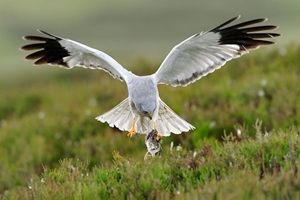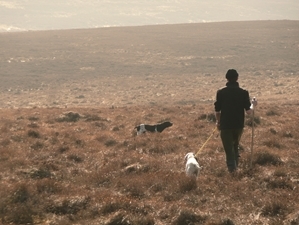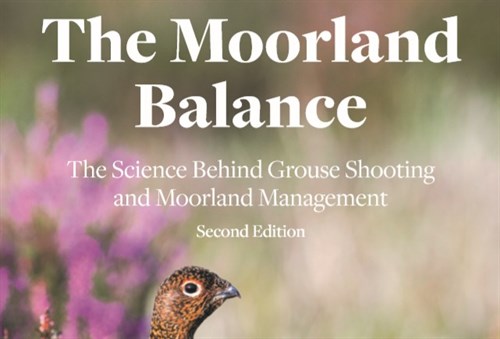Key points
- Scientists collected data on populations of red grouse, hen harriers and other predators at Langholm Moor in southwest Scotland between 1992 and 2015.
- During the study period the moor saw the ending (in 1999) and subsequent restarting (in 2008) of grouse moor management.
- Overall, grouse moor management had a positive effect on abundance and breeding success of red grouse and hen harriers. This means that both species can benefit from grouse moor management as long as hen harriers are not being persecuted.
Background
 Large areas of heather moorland in the UK uplands are managed for shooting red grouse, which includes managing heather and legally controlling some predator species (e.g. red foxes and carrion crows). Managing moorland in this way benefits grouse as well as some other ground-nesting upland birds. However, it has also been linked to illegal persecution of raptors, particularly hen harriers.
Large areas of heather moorland in the UK uplands are managed for shooting red grouse, which includes managing heather and legally controlling some predator species (e.g. red foxes and carrion crows). Managing moorland in this way benefits grouse as well as some other ground-nesting upland birds. However, it has also been linked to illegal persecution of raptors, particularly hen harriers.
At Langholm Moor in southwest Scotland, studies have been ongoing since 1992 to look at the relationship between red grouse and hen harrier. Between 1992 and 1997, while managed as a grouse moor, hen harrier numbers increased, and red grouse numbers fell to levels too low to sustain driven shooting. Consequently, grouse moor management stopped in 1999. Langholm Moor remained unmanaged until 2008, when grouse moor management was restarted for the Langholm Moor Demonstration Project.
This study looked at how the stopping and restarting of grouse moor management affected the abundance and breeding success of red grouse and hen harrier, as well as the abundance of their perceived key predators: red fox and carrion crow.
What they did
 The scientists monitored red grouse, hen harrier, red fox and carrion crow during three different management periods. First between 1992 and 1999, when Langholm Moor was managed as a grouse moor. Second between 2000 and 2007, when the moor was not managed for red grouse. Third from 2008 to 2015, when grouse moor management was restarted with the aim of restoring driven grouse shooting.
The scientists monitored red grouse, hen harrier, red fox and carrion crow during three different management periods. First between 1992 and 1999, when Langholm Moor was managed as a grouse moor. Second between 2000 and 2007, when the moor was not managed for red grouse. Third from 2008 to 2015, when grouse moor management was restarted with the aim of restoring driven grouse shooting.
Red grouse were counted using pointing dogs before and after the breeding season to work out their density and breeding success. Hen harrier nests were found in spring and then monitored throughout the breeding season to record how many breeding attempts were successful (rearing at least one chick) and the number of chicks that were successfully reared.
Carrion crow abundance was estimated by counting all crows seen or heard during breeding bird surveys. Red fox activity was estimated from 2003 onwards by counting the number of scats found along survey paths in the study site.
What they found
Grouse moor management had a positive effect on the abundance and breeding success of red grouse and hen harriers, which were two- to three-fold higher when fox and crow abundance were reduced by 50-70%.
Red fox activity was negatively correlated with red grouse density and hen harrier breeding success. Carrion crow abundance was negatively correlated with red grouse breeding success.
What this means
This study confirms that both red grouse and hen harriers can benefit from the predator control associated with grouse moor management, if hen harriers are not persecuted. However, restarting grouse moor management, in combination with diversionary feeding of hen harriers, did not result in a high enough red grouse density to allow driven shooting on Langholm Moor.
Read the original abstract
Ludwig, S.C., Roos, S., Bubb, D., & Baines, D. (2017). Long-term trends in abundance and breeding success of red grouse and hen harriers in relation to changing management of a Scottish grouse moor. Wildlife Biology, 2017: wlb.00246: 1-7. DOI: 10.2981/wlb.00246.
About the LMDP
This study was part of the Langholm Moor Demonstration Project, a long-running collaboration between the GWCT, SNH, Buccleuch Estates, the RSPB and Natural England, which aimed to resolve the conflict between driven grouse shooting and raptor conservation. Further papers from the Langholm Moor Demonstration Project can be found on the LMDP website.
Photo credit: Laurie Campbell

The Moorland Balance - eBook - only £4.99
Get the science behind grouse shooting and moorland management. Building on the success of the first edition, this new and improved version condenses thousands of pages of scientific literature into easy-to-read questions and answers. Over 200 different studies from across the scientific community are referenced in this 134-page book.
View Book >
or
Buy Now - £4.99 >
100% Secure. All Credit & Debit cards, PayPal, Apple Pay and Google Pay accepted.
